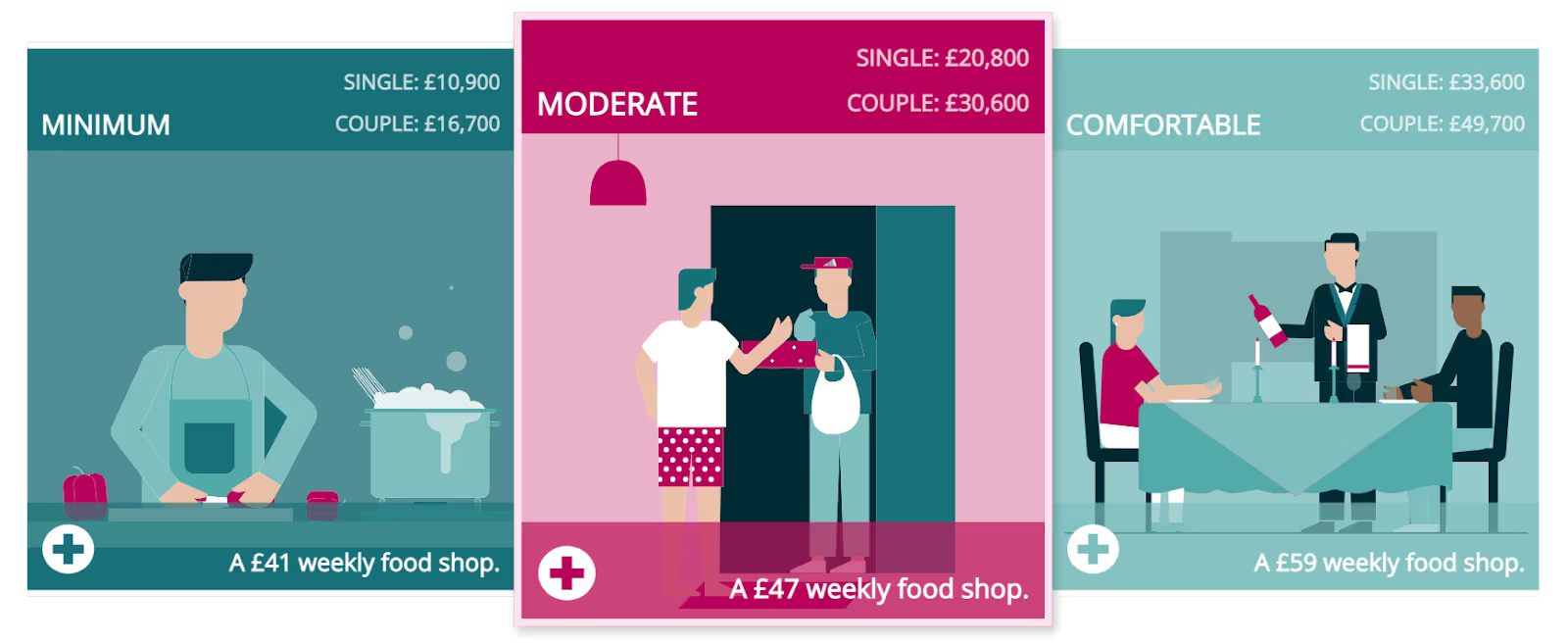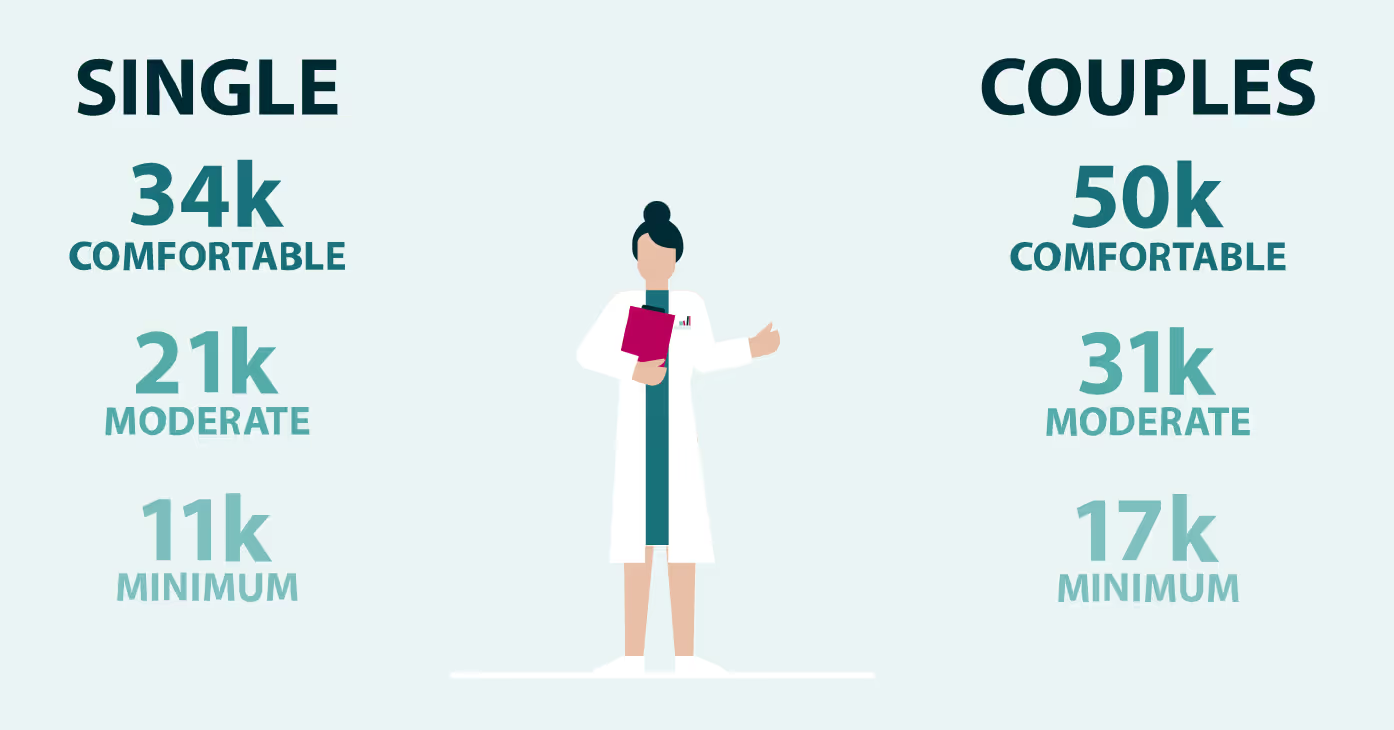How much do you need to retire?
It’s the £1m question (quite literally if you have a look at the lifetime pension allowance) but it’s absolutely not one-size-fits-all.
We all have different visions of what we want once we clock out of the office for the last time. Those plans, and our ability to invest for them, can change quite a lot from person to person.
Thankfully, it’s a spectrum the Pension and Lifetime Savings Association (PLSA) has tried to simplify.
In its most recent retirement living standards report, the PLSA has crunched the numbers on everything from how much we plan to spend on DIY to clothes in retirement.
The goal here is to not just think about money, but rather what your ideal lifestyle would look like, and how to match your pension goals to it.
Do you need to level up your pension contributions?
Breaking it down into three tiers, the PLSA findings show we need to be aiming for an income of £33,600 in retirement to live a comfortable life.
They’ve defined ‘comfortable’ as being able to jet off on a European holiday for three weeks every year, spending £1,200 on clothes annually and doing up the kitchen and bathroom every 10-15 years.

There are a few more measurements in there to get that sum but the crux of this level is that it provides financial freedom for the lion’s share of the UK, and allows for some of life’s luxuries too.
A ‘moderate’ standard of living comes with a price tag of £20,800 according to the research and reflects spending £730 on clothes as well as a two week getaway instead, plus a long weekend in the UK.
Overall, the PLSA says this level offers financial security and flexibility over high-end purchases.
Probably most important is what the study shows is the minimum we need to cover all our needs with a bit of cash left over for fun.
That comes in at £10,900 per year and assumes we only holiday in the UK, don’t own a car and spend £410 on clothes each year.
Rules of thumb aren’t concrete
It can be incredibly useful to have a yardstick to guide where we want to be, come retirement age.
But how you actually replicate those income examples depends entirely on what you have in the pension pot.
A guide a lot of people use to get there is to multiply their desired income by 25. That allows them to withdraw 4% of their pot each year with plans to replenish that through investment growth in time for next year’s withdrawals.

Of course, that can’t be guaranteed as the market moves up and down constantly, but 4% lies in the 3-5% long-term average for dividend payments in the UK.
That means it can be a sensible target withdrawal amount as it’s not too much to make up through investment growth and won’t deplete the pot you start with.
If we follow that guide, you’d need the following pots to hit the PLSA’s income levels. The UK average salary of around £30,000 is there too for reference:
- Comfortable: £33,600 x 25 = £840,000
- UK average salary: £30,000 x 25 = £750,000
- Moderate: £20,800 x 25 = £520,000
- Minimum: £10,900 x 25 = £272,500
Again, these are just guides to help you see what your lifestyle will require from your savings. You’ll likely have the state pension to add in there too and you might be able to share certain costs if you are in a couple, bringing some outgoings down.
Throw in things like plans to pay off the mortgage with a 25% tax-free lump sum upon retiring and you can see how even the simplified versions become deeply personal very quickly.
So, how do I get there?
There’s really no point lecturing everyone about the ‘ideal’ amount to squirrel away each month. Hopefully this whole article is evidence enough of that.
Despite what our goals might be, everyone has their own unique ability to contribute to and manage their pension.
In fact, the numbers above might actually serve as a bit of a wake-up call for people wanting to live the high life, but who haven’t really thought about investing enough to get there.
Read more:
Five ethical stocks for your pension
Your three-minute pension check-in
Sign up to Honey, our free regular market newsletter
So, while we can talk in general terms about assets, you’ll have to decide what’s right for you.
For a lot of people, reading around and doing a bit of investment research will give them the confidence to go ahead. Getting to grips with the basics of investing can help.
But if that doesn’t sound like you, think about talking to a financial adviser instead.
That said, let’s talk investing.
Investing in you
If you stand back from a historical stock market graph, suddenly the short-term jagged edges disappear and you can see the general trend, which history shows us is towards the top right of the page.
Following this logic, that’s why it can make sense to be big on equities (company shares) when you’re young, leaving room for some bonds, commodities like gold and even property to provide diversification.
But while having your full working life ahead of you can make equities attractive at the start, it’s incredibly difficult to predict the winners and losers 35 years out.
Look at the developments of the past 35 years - the companies that have benefited, the countries facilitating new trends and the sectors moving the needle.
Diversify, diversify, diversify
That’s why diversification by geography, sector and company size is key too.
While the general idea here is to give your investments as much opportunity to tap into as many sources of growth as possible, ultimately they have to suit your tolerance for risk.
Creating a portfolio with a diverse set of assets in line with your goals and risk tolerance means you’re open to opportunities without being overexposed to a single company or theme.
One example is having broad exchange-traded funds (ETFs) covering global markets form the bedrock of your equity exposure.
You can supplement these holdings with smaller positions in individual companies or assets like investment trusts in what is called a ‘core and satellite’ approach.
Make investing a habit
Some employers will offer to contribute more to your pension if you do too. It’s worth asking about what their position is, and taking full advantage of any perks here if you can.
Make sure you’re saving regularly too. It breaks up what can feel like a mammoth task into achievable chunks.
And when you invest at regular intervals, say monthly, you’ll naturally catch both the highs and lows of the market.
The result is that, over the long term, you tend to achieve a return somewhere in between, without trying to guess when the best time to invest is.
Should I transfer my pension?
Young people today are predicted to change jobs up to 14 times during their careers. That means it will become very easy to lose track of a pension pot or two.
According to the Association of British Insurers around £19.4bn is currently sitting in lost or unclaimed pensions in the UK.
Don’t become part of this statistic.
The ease of keeping all your pensions in one place might be a reason to consider transferring them into a SIPP.
Other reasons might be that your current provider(s) have pension fees, limited investment options or poor visibility of what you’re actually invested in.
If you are looking at the PLSA’s figures and want to take control of your own future, a SIPP might help.
But don’t rush into it.
Before you make any changes to your current pension plans, you need to make sure transferring would be right for you. If you need to, get help from a financial adviser.
Here are some things to think over:
- Is your current provider going to charge you any exit-fees?
- Will you lose any valuable benefits or guarantees?
- Consider how long the transfer might take and what impact this might have on your existing portfolio.
Take control of your retirement savings with a Freetrade self-invested personal pension. Start a SIPP today and contribute regularly or transfer old pensions to one single pot you can grow and manage yourself.
Important information on SIPPs
SIPPs are a pension product designed for people who want to make their own investment decisions. You can normally only access the money from age 55 (set to rise to 57 from 6 April 2028).
This article is based on current rules, which can change, and tax relief depends on your personal circumstances. When you invest, your capital is at risk.
The value of your portfolio can go down as well as up and you may get back less than you invest.
Before transferring a pension you should ensure you will not lose valuable guarantees or incur excessive transfer penalties. Pensions are usually transferred as cash so you will be out of the market for a period.
Freetrade does not currently offer drawdown products for our SIPP.
This should not be read as personal investment advice and individual investors should make their own decisions or seek independent advice. This article has not been prepared in accordance with legal requirements designed to promote the independence of investment research and is considered a marketing communication.When you invest, your capital is at risk. The value of your portfolio can go down as well as up and you may get back less than you invest. Past performance is not a reliable indicator of future results.Freetrade is a trading name of Freetrade Limited, which is a member firm of the London Stock Exchange and is authorised and regulated by the Financial Conduct Authority. Registered in England and Wales (no. 09797821).

.avif)






.avif)



